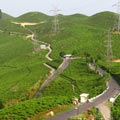Making pu-erh tea: Pan-frying
„“

Video Tags: China, Pu-erh, Tea production, Yunnan
- Discussion: 0 comments
- Write a comment
Teas - Pu-erh
2011 Raw Puerh Tea Paste "Cha Gao" 25g
 0 reviews
0 reviewsAlmost on the verge of disappearing, Pu-erh tea paste used to be the special tribute to...
2005 (2015) Chawangpu Bulang Shan Old
 0 reviews
0 reviewsThis tea was found in friend´s warehouse in Menghai where was stored since 2005. Clean...
2009 Menghai "Spring of Menghai" Raw
 1 review
1 reviewThis is a newer Menghai release, first released in 2005 and then again in 2006, 2007,...
2012 Myanmar - Beyond The Small Mengsong
 1 review
1 reviewThe raw materials of this cake came from villages in Myanmar, its north border on small...
2007 Boyou "Man Lu Da Shan" Meng Song
 2 reviews
2 reviewsBoyou tea factory was started by yet another ex-Menghai tea blender. Boyou is well...
Quotes - Pu-erh
„Bitterness
Broad leaf variety (Sinenesis Assamica) is high in natural constituents; polyphenols, caffeine,theine, etc. A particularly bitter flavour is a special characteristic of the Broad leaf variety, but it is important that it transforms quickly and does not linger. This is a mark of good quality Puer. NB there is a sub-variety in Yunnan - Var. ku cha which has different characteristics and does not transform in the same way.“

Quotes Tags: Pu-erh, Experiencing tea
Video - Pu-erh
Teas
Lao ManE 2013 autumn
 1 review
1 reviewThe LaoManE rules over this autumn teas. In this village you may find really bitter tea and also sweet teas...
SeJak 2014 ECO Korea
 1 review
1 reviewKorean green tea picked in the spring of 2014 in Hadong district, Jiri mountains. Grown and produced by an...
2007 Jingmai Qiao Mu “0502”
 1 review
1 reviewUse Jingmai mountain arbor (Qiao Mu) tea which picked before Grain Rain (mid-April) as raw material, this...
Theme
Tea by region
We will help you with tea selection.
Do you like quality loose tea?
We will help you to find the right one for you. Be inspired by tea ratings of other tea lovers. Rating stars could help you.


Review your cup of tea.
Review the tea you are drinking and help other tea lovers to find the right cup of tea.



Quotes
„Smokiness
The art of making tea from ancient tea trees is very old. Hand-roasting is not easily mastered. Any slight error will influence the taste of the tea. Smokiness or yan wei is one example but it should be distinguished from a burned flavour which is described as hu wei. The latter, typically arises when tea is not well roasted and is, unfortunately, not uncommon. Yan wei or smokiness is caused by oven drying. “



 Shops
Shops Share on Facebook
Share on Facebook























